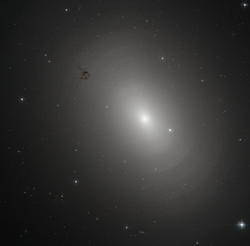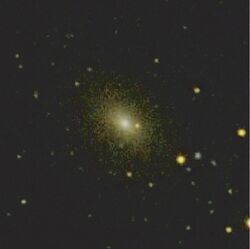Astronomy:NGC 3923
| NGC 3923 | |
|---|---|
 NGC 3923 by Hubble Space Telescope | |
| Observation data (J2000 epoch) | |
| Constellation | Hydra |
| Right ascension | 11h 51m 01.7s[1] |
| Declination | −28° 48′ 22″[1] |
| Redshift | 0.005801 +/- 0.00003 km/s[1] |
| Distance | 71 ± 23 Mly (21.6 ± 7.0 Mpc)[1] |
| Apparent magnitude (V) | 9.6 |
| Characteristics | |
| Type | E4-5 [1] |
| Apparent size (V) | 5.9′ × 3.9′[1] |
| Notable features | Shell galaxy |
| Other designations | |
| ESO 440- G 017, AM 1148-283, MCG -05-28-012, PGC 37061[1] | |
NGC 3923 is an elliptical galaxy located in the constellation Hydra. It is located at a distance of circa 90 million light years from Earth, which, given its apparent dimensions, means that NGC 3923 is about 155,000 light years across. NGC 3923 is an example of a shell galaxy where the stars in its halo are arranged in layers. It has more than twenty shells.[2] It was discovered by William Herschel on March 7, 1791.
Characteristics
NGC 3923 is an example of a shell galaxy where the stars in its halo are arranged in layers. NGC 3923 has up to 42 shells, the highest number among all shell galaxies,[3] and its shells are much more subtle than those of other shell galaxies. The shells of this galaxy are also symmetrical, while other shell galaxies are more skewed and asymmetrical. Concentric shells of stars enclosing a galaxy are quite common and are observed in many elliptical galaxies. In fact, every tenth elliptical galaxy exhibits this onion-like structure, which has never been observed in spiral galaxies. The shell-like structures are thought to develop as a consequence of galactic cannibalism, when a larger galaxy ingests a smaller companion. As the two centers approach, they initially oscillate about a common center, and this oscillation ripples outwards forming the shells of stars just as ripples on a pond spread when the surface is disturbed.[2]
Deep imaging also detected a stream extending from the core of NGC 3923 and a small elliptical galaxy on its axis, which is a probable progenitor of some of the shells. Another stream lies south of the core of NGC 3923, and a hook like structure lies at the northwest.[3]
Based on the velocity dispersion of the globular clusters of NGC 3923 the mass of the supermassive black hole of the galaxy was estimated to be (5.3±2.5)×108 M☉.[4]
Supernovae
One supernova has been detected in NGC 3923, SN 2018aoz, a type Ia supernova with peak magnitude 12.7. It was discovered on April 2, 2018.[5]
Nearby galaxies
NGC 3923 is the brightest galaxy in a galaxy group known as the NGC 3923 galaxy group. Within 25 arcminutes from NGC 3923 have been detected seven dwarf elliptical galaxies. NGC 3904 is located 37 arcminutes away.[6] Other galaxies in the group include NGC 3885, ESO 440-27, and ESO440-011. Other nearby galaxies include NGC 3617, NGC 3673, NGC 3717, NGC 3936, and NGC 4105.[7]
References
- ↑ 1.0 1.1 1.2 1.3 1.4 1.5 1.6 "NASA/IPAC Extragalactic Database". Results for NGC 3923. http://ned.ipac.caltech.edu/cgi-bin/nph-objsearch?objname=NGC+3923.
- ↑ 2.0 2.1 "Hubble Spots the Layers of NGC 3923". NASA. May 15, 2015. https://www.nasa.gov/image-feature/goddard/hubble-spots-the-layers-of-ngc-3923.
- ↑ 3.0 3.1 Bílek, M.; Cuillandre, J.-C.; Gwyn, S.; Ebrová, I.; Bartošková, K.; Jungwiert, B.; Jílková, L. (22 March 2016). "Deep imaging of the shell elliptical galaxy NGC 3923 with MegaCam". Astronomy & Astrophysics 588: A77. doi:10.1051/0004-6361/201526608. Bibcode: 2016A&A...588A..77B.
- ↑ Sadoun, Raphael; Colin, Jacques (11 October 2012). "-σ relation between supermassive black holes and the velocity dispersion of globular cluster systems". Monthly Notices of the Royal Astronomical Society: Letters 426 (1): L51–L55. doi:10.1111/j.1745-3933.2012.01321.x. Bibcode: 2012MNRAS.426L..51S.
- ↑ "List of supernovae sorted by Magnitude for 2018". http://www.rochesterastronomy.org/supernova.html#2018aoz.
- ↑ Sandage, A., Bedke, J. (1994). The Carnegie Atlas of Galaxies. Carnegie Institution of Washington.
- ↑ Makarov, Dmitry; Karachentsev, Igor (21 April 2011). "Galaxy groups and clouds in the local (z~ 0.01) Universe". Monthly Notices of the Royal Astronomical Society 412 (4): 2498–2520. doi:10.1111/j.1365-2966.2010.18071.x. Bibcode: 2011MNRAS.412.2498M. http://www.sao.ru/hq/dim/groups/galaxies.dat. Retrieved 8 July 2018.
External links
- NGC 3923 on WikiSky: DSS2, SDSS, GALEX, IRAS, Hydrogen α, X-Ray, Astrophoto, Sky Map, Articles and images

 |

